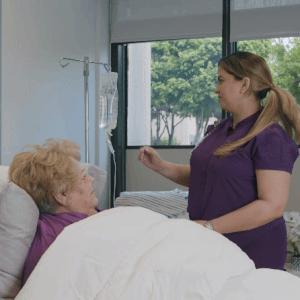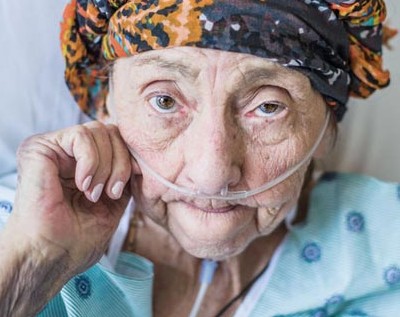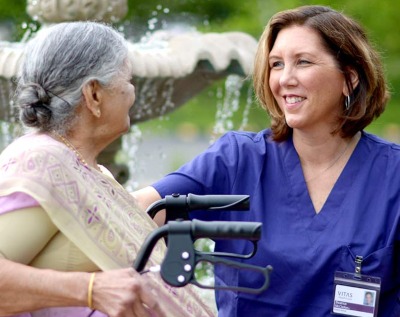When Symptoms Require a Higher Level of Care: VITAS Inpatient Units for Short-Term Clinical Care
What happens when a hospice patient has a medical crisis or experiences symptoms that cannot be managed at home? Rather than returning to the ED, VITAS offers another option: symptom optimization at an inpatient unit (IPU). IPUs offer a higher level of care in a comforting, onsite environment.
Under the Medicare Hospice Benefit, all hospices must offer GIP (general inpatient) level of care to assess and manage acute, complex, or uncontrolled symptoms such as pain or shortness of breath, with IPUs being one example of a GIP care setting. However, the delivery of this care may vary by provider.

VITAS RN cares for a hospice patient in an inpatient unit (IPU).
VITAS IPUs and suites are staffed by a VITAS care team, including a physician who makes daily rounds and nurses who provide 24/7 care. Integrated team members such as social workers, chaplains, music therapists, and Paw Pals® pet visits provide psychological and social support as needed*. Typically, many VITAS IPUs have accommodations for family members to stay so they are near their loved one.
Four Levels of Care
General inpatient hospice (GIP) care is one of four levels of care VITAS offers under the Medicare Hospice Benefit. When a VITAS physician determines that a hospice patient is eligible for GIP level of care,** VITAS collaborates with the hospital or facility staff to coordinate a comfort-focused plan of care.
Other levels of care (LOC) include:
- Routine Home Care in the patient’s residence (private home or senior living community) with scheduled, routine visits by care team members, including hospice physician, registered nurse, aide, social worker, chaplain, volunteer, and bereavement specialist. This is the most common type of hospice care.
- Continuous Home Care, which brings shifts of acute symptom management to the patient’s bedside for up to 24 hours/day. VITAS calls this Intensive Comfort Care®.
- Inpatient Respite Care provides a temporary break for primary caregivers who are at risk for burnout. Hospice patients receive 24-hour care in a Medicare-certified hospital, hospice facility, or long-term care facility for up to five days.
Short-term Inpatient Clinical Care*
At an IPU, the patient receives intensive, high-acuity care that may be too challenging to provide in their home environment. If the patient needs frequent dose changes in analgesic or other medication or treatment that require close monitoring, is having new or recurrent seizures, or has wounds that need frequent dressing changes that cannot be done in the home, the patient may benefit from an IPU stay.
While some procedures can be handled by VITAS Intensive Comfort Care® in the home, others are better suited for an inpatient setting where things are more controlled and other treatments are readily available, such as paracentesis or thoracentesis. If a cancer patient’s hemoglobin drops quickly, they may need a blood transfusion to restore their strength, which may be administered in a hospital-based IPU.*
These are only some examples of clinical care that may mandate an IPU short-term stay. Once admitted, the hospice care team:
- Evaluates symptoms
- Provides intensive symptom management
- Maintains around-the-clock care and regular visits
Similar to other levels of care, Medicare payments for inpatient care include all services, medications, equipment, and supplies related to the terminal illness. When care unrelated to a patient’s advanced illness is necessary, Medicare Parts A and B may cover expenses under normal rules.
Home-Like Environment Focuses on Comfort
VITAS units offer amenities like family rooms, kitchens, and children’s play areas. We include places for quiet contemplation or prayer and spaces that accommodate the needs of multiple generations. A cup of coffee and facilities to reheat a home-cooked meal are always available.
Like the physical surroundings, the environment is soothing and family oriented. Team members get to know patients and their loved ones and include them in care. They may help out-of-towners navigate the area or welcome the visit of a beloved pet. This enhances quality of life for patients and families even when intensive care is necessary.
Returning Home
The goal of the short-term stay in an IPU is to provide the clinical care and onsite monitoring to stabilize the patient so they can return home. Once the patient’s crisis improves, the interventions or medications that require skilled nursing care may no longer be necessary.
Upon leaving the IPU, the patient’s hospice services will resume in their home or senior living community. They will return to their previous level of care with 24/7/365 clinical support from VITAS, high-acuity care, and full interdisciplinary team services to promote comfort and dignity.
Have a patient with serious illness who may be hospice eligible? Refer to VITAS today.
*May vary by VITAS program and requires clinical case discussion between the VITAS medical director and attending physician. Demonstrates VITAS® Healthcare care model, not all hospices may provide listed services. In addition to the complex modalities, the following may be incorporated in a patient’s plan of care: Goals-of-care conversations, PT, OT, speech therapy, nutritional counseling and specialized HME.
**Per Medicare guidelines, higher levels of care are provided when a VITAS physician determines a patient is eligible for a higher level of care (LOC) or GIP. Eligibility to remain on a higher LOC is assessed by a VITAS RN and VITAS physician daily. Higher LOCs are provided on a temporary basis until the symptom(s) are optimally managed.

